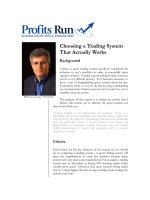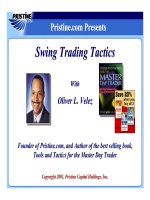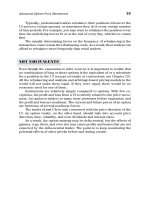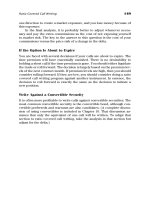Trade my way share trading tactics that really work for novices to experts ( PDFDrive )
Bạn đang xem bản rút gọn của tài liệu. Xem và tải ngay bản đầy đủ của tài liệu tại đây (4.77 MB, 261 trang )
prelims.indd ii
6/20/11 7:28 AM
TRADE
*
MYWAY
MY
WAY
prelims.indd i
6/20/11 7:28 AM
prelims.indd ii
6/20/11 7:28 AM
TRADE
*
REVISE
EDITIO D
N
MYWAY
MY
WAY
ALAN HULL
prelims.indd iii
6/20/11 7:28 AM
First published in 2011 by Wrightbooks
an imprint of John Wiley & Sons Australia, Ltd
42 McDougall St, Milton Qld 4064
Office also in Melbourne
Typeset in Berkeley LT 11/14
© Alan Hull 2011
The moral rights of the author have been asserted
National Library of Australia Cataloguing-in-Publication data:
Author:
Hull, Alan, 1962-
Title:
Trade my way: share trading tactics that really work,
for novices to experts / Alan Hull.
ISBN:
9780730375807 (pbk.)
Notes:
Includes index.
Subjects:
Stocks.
Speculation.
Stock exchanges.
Investments.
Dewey Number:
332.63228
All rights reserved. Except as permitted under the Australian Copyright Act
1968 (for example, a fair dealing for the purposes of study, research, criticism
or review), no part of this book may be reproduced, stored in a retrieval system,
communicated or transmitted in any form or by any means without prior written
permission. All inquiries should be made to the publisher at the address above.
Cover design by Peter Reardon, Pipeline Design <www.pipelinedesign.com.au>
Back cover image: used courtesy of Sky News
Microsoft Excel tables and screenshots used with permission from Microsoft.
Printed in China by Printplus Limited
10 9 8 7 6 5 4 3 2 1
Disclaimer
The material in this publication is of the nature of general comment only, and
neither purports nor intends to be advice. Readers should not act on the basis of
any matter in this publication without considering (and if appropriate, taking)
professional advice with due regard to their own particular circumstances. The
author and publisher expressly disclaim all and any liability to any person,
whether a purchaser of this publication or not, in respect of anything and of the
consequences of anything done or omitted to be done by any such person in
reliance, whether whole or partial, upon the whole or any part of the contents of
this publication.
prelims.indd iv
6/20/11 7:28 AM
Contents
Acknowledgements
About the author
Preface
ix
xi
xiii
Part I: A few things you should know
1 What is share trading?
2 What is charting?
3 Modern technical analysis
4 Risk management
5 Anatomy of a trade
Part II: Active trading
6 Introduction to active trading
7 Tools of the trade for active trading
8 Taking active trading for a test drive (by Simon
Sherwood)
Part III: Breakout trading
9 Introduction to breakout trading
10 Tools for breakout trading
11 Applying the breakout trading strategy
12 Taking breakout trading for a test drive
(by Janice Korevaar)
1
3
15
29
47
65
81
83
93
107
131
133
147
163
175
v
prelims.indd v
6/20/11 7:28 AM
Trade My Way
Part IV: In conclusion
13 The biggest problem is you
14 Keep your eye on the ball
15 Blue chip share trading
193
195
203
213
Appendix A: MetaStock indicator formulae
for active trading
Appendix B: MetaStock indicator formulae
for breakout trading
Appendix C: Trading performance and strategy
review
Index
221
223
225
229
vi
prelims.indd vi
6/20/11 7:28 AM
This book is dedicated to a good friend of mine
A man who works very hard at trying to be successful
A man who works hard to make his own luck
A man who will get lucky and succeed
This book is dedicated to Mark
Successful share trading is about hard work and having the
strength of character to persevere. You will encounter hardship and
you will suffer losses. At times, you will also get lucky. This book
is a road map for those who are prepared to work hard and get
lucky . . . like Mark.
prelims.indd vii
6/20/11 7:28 AM
prelims.indd viii
6/20/11 7:28 AM
Acknowledgements
Simon Sherwood
The hardest thing about writing a book is making the command
decision at the start to actually do it. This is especially the case when
you’re an experienced author and you know full well the size of the
task that lies ahead of you. Luckily for me, I’ve always got you to
push me over the edge. This book just simply wouldn’t have been
written without your encouragement and support.
Janice Korevaar
You don’t talk much, you just get on with it. What people call a quiet
achiever. I also can’t quite pinpoint when you first showed up . . . but
I’m glad you did.
Debra (my wife)
Writing a book requires a large commitment, in terms of both time
and focus. In order to make that commitment, one’s life must be
anchored on a very solid foundation. You are my foundation.
Matthew and Kathryn (my children)
Every time I write a book, we lose some of the time we could be
spending together. But I hope you can appreciate the commitment
both Mum and I put into achieving our goals and I believe this serves
as a valuable example to you. So please follow our example, but not
our footsteps. Go and make your own . . .
ix
prelims.indd ix
6/20/11 7:28 AM
prelims.indd x
6/20/11 7:28 AM
About the author
A second generation share trader, Alan Hull owned his first share
when he was just eight years old. As a result of his early start in the
stock market, most of the lessons that the average trader or investor
learns during their adult life were second nature to Alan by the time
he was 21.
Alan has also had a keen interest in mathematics from a very young
age and was an IT expert from the early days of personal computing.
Employing this combination of skills and his experience over the
past two to three decades as a modern share trader has transformed
Alan into one of Australia’s leading stock market experts.
Alan is highly respected within the Australian investment industry,
regularly writing articles and presenting for the Australian Securities
Exchange, the Australian Technical Analysts Association, the
Australian Investors Association, and the Traders and Investors
Expo. And apart from writing his own best-selling books, he has
also contributed to other publications, such as Martin Roth’s very
successful Top Stocks series, Daryl Guppy’s international book Better
Stock Trading, Jim Berg’s series Shares to Buy and When, and Wiley
Trading Guide.
But rather than being content as a private trader, author and educator,
Alan is also a licenced financial adviser. Over the past few years
Alan has successfully managed millions of dollars of other people’s
money, consistently beating all the major ASX market averages. One
of Alan’s most notable decisions as a fund manager was to move his
entire fund to cash at the start of August 2007, thus preserving his
clients’ capital throughout one of the worst global financial crises of
the past century.
xi
prelims.indd xi
6/20/11 7:28 AM
Trade My Way
With a focus on the practical, Alan lays it out in black and white
in this tell-all book on how he trades the Australian stock market.
Like his other books, this one will no doubt become compulsory
reading for anyone who hopes to successfully trade the Australian
stock market.
xii
prelims.indd xii
6/20/11 7:28 AM
Preface
Knowledge is valuable. Either someone else passes on knowledge to
us or we acquire it for ourselves, the latter approach usually involving
some degree of pain. A typical example is sticking your hand in a fire.
I know I was told by my father not to stick my hand in the fire or
I’d get burnt, but I was (and still am) the type of person who has to
discover these sorts of dangers for myself.
When speaking publicly, I often say that I’m in possession of what
I know today because of the money I have lost in the market, not
because of the money I’ve made. I’ve stuck around because I have a
fairly high psychological pain threshold and I’m extremely stubborn
(psychology is a major aspect of share trading and we therefore
discuss it in chapter 13). I have suffered greatly in my life to work out
what does work and what doesn’t work, and I’ve found that sticking
my hand in a fire will burn my fingers.
The stock market is very much like life in general, where one learns
what works by spending a great deal of time and energy working out
what doesn’t work. I bought my first share when I was only eight
years old, so I’ve spent a very large proportion of my life testing a
very wide range of different trading tactics. I’ve tried using tips and
rumours, expert analysis from different gurus and media sources,
piggybacking the likes of Kerry Packer and Warren Buffett, and even
cyclical analysis.
Here’s what I discovered — all these techniques work and don’t work.
Their success depends largely on when you use them, so at some
point all these different approaches will make you money, but at
some point they’ll also take it away again. It’s like the old saying
about a broken watch being right twice a day — unless it works all
xiii
prelims.indd xiii
6/20/11 7:28 AM
Trade My Way
the time, it’s useless. So it is with share trading tactics: either they are
universal in their application or they are effectively useless, not to
mention costly.
There are a lot of broken watches out there when it comes to share
trading, so the first problem any newcomer to the stock market will
encounter is the problem of sorting through so many choices when
it comes to share trading ideas, philosophies, systems and strategies.
To help you deal with all of these distractions and stay focused, I
discuss the problem of the noise in the marketplace in chapter 14.
Hopefully being aware of the issue will help you to deal with it. To be
forewarned is to be forearmed.
Call it a collection of observations, facts and/or truths — the knowledge
that I have accumulated in my lifetime has often been obtained at
great personal expense. This particularly applies to the knowledge I
possess about the stock market. This book is based on my knowledge
of the stock market and share trading, namely two key facts that I
have come by at great personal expense. I hope that I can pass this
knowledge on to you through this book, saving you much of the pain
that I have endured at the hands of the stock market.
My two key facts about the stock market are:
•
•
share prices tend to trend
share prices cannot remain at rest indefinitely.
I know these two observations sound ridiculously simple, and they
are, but the reality I’ve discovered over many years of share trading is
that any strategy based on them works and will most likely continue
to work in the future. While there may be periods in the market
when these observations don’t work, they can generally be treated as
universal observations, or facts, when it comes to trading shares.
‘Share prices tend to trend’ is probably the most obvious of these two
observations and you don’t have to look very far to see this. If you
look at a long-term chart of the Australian All Ordinaries (All Ords)
index, which is an aggregate of about 300 shares and can, therefore,
be considered as representative of the behaviour of the Australian
stock market in general, you can clearly see that the market has a
xiv
prelims.indd xiv
6/20/11 7:28 AM
Preface
strong tendency to trend either up or down for sustained periods
of time. Of course, this behaviour is also inherent to the individual
shares that make up the All Ords index as well.
Now to my second observation: a share’s price cannot remain at
rest indefinitely. Price activity consolidates down to what chartists
call a point of agreement and then ‘breaks out’ from this point. Like
trending, this is a commonly observed phenomenon when it comes
to share price behaviour, and one that traders can easily and reliably
profit from by anticipating and then buying into the ensuing rally.
To consistently take profits from the stock market, we need to employ
a trading strategy or strategies that exploit these robust behavioural
traits. Thus, from these two key observations comes my two trading
systems: active trading and breakout trading. This book explains
these two strategies in detail. Chapters 6–8 are dedicated to active
trading, and chapters 9–12 deal with breakout trading.
Like the observations they’re based on, these trading systems are
both robust and reliable. I’d also love to say that these systems are
as simple as the concepts behind them, but that would be somewhat
misleading. A reality of share trading is that some maths is involved
and therefore it is an advantage if you are numerically literate.
But before we launch into any detailed technical explanations, we
start out at a very sedate pace by simply addressing the basic question
of ‘What is share trading?’ in chapter 1. The story builds from there
and while there’s plenty of interesting stuff for both the newcomer
to the stock market and the more experienced, I certainly don’t offer
any magic bullet solutions.
In fact, apart from showing you what does work, I’m also going to
debunk a few myths, such as the silly notion that currency trading is
as easy as share trading, or that successful trading systems have to be
complicated and expensive. Most of these spurious notions are put
out by product vendors who are the only ones who actually make a
profit by them.
This book focuses essentially on observing and analysing price
behaviour. Understanding how to read and interpret price charts is
xv
prelims.indd xv
6/20/11 7:28 AM
Trade My Way
critical to both fully appreciating this book and being a successful
trader. For this reason I have dedicated chapters 2 and 3 entirely to
understanding price charts.
The common attribute of all successful trading systems is quantitative
risk management, which we cover in chapter 4. Most books on share
trading leave this subject until near the end of the book, but I thought
I would break with this convention and include it in one of the early
chapters. Hopefully this means that no-one will put this book down
before being exposed to this vitally important subject.
While it is not absolutely critical to success, a common feature of
successful people in any walk of life is the ability (and discipline)
to organise themselves. To be organised, you need to be systematic,
and share trading lends itself easily to being broken down into
step-by-step, systematic processes. We use a proven share trading
system in chapter 5 and break it down into its separate key processes
in order to demonstrate this.
The trading system used in chapter 5 is my active investing strategy,
which is a medium- to long-term blue chip share trading strategy.
This book primarily focuses on short-term trading tactics. However,
to provide you with the complete picture of how I trade shares, it is
appropriate that I at least cover blue chip share trading in brief. For
this reason, the last chapter also addresses the question of how to
trade these elephants of the stock market.
It should be clearly understood that the trading systems contained
in this book are medium risk and should be combined with a
low-risk approach, such as my active investing strategy, to achieve a
total share trading solution.
Many books of this kind contain recommendations about what
material is compulsory reading and which sections can be skipped.
I am not in favour of giving this sort of direction because I rarely
include optional material in my books. But that said, a lot of modern
charting software includes my indicators and, therefore, it is not
entirely necessary that you fully comprehend the details on indicator
construction.
xvi
prelims.indd xvi
6/20/11 7:28 AM
Preface
This book covers two short-term, medium-risk share trading strategies
that have been well proven over years of application to the Australian
stock market. While these strategies have a degree of universality,
this book does not cover currency trading, index trading, options,
warrants, futures or CFDs. Furthermore, the indicators described in
this book have been tuned for trading Australian shares and should
not be applied to any other type of financial market or product
without very careful adjustment.
I would like to acknowledge the contributions to this book by Simon
Sherwood and Janice Korevaar. Not only did they both make my
life considerably easier, but they also added their voices to the text,
which I believe has greatly enriched it.
I hope you find your journey through this book both enlightening and
enjoyable, and that you take away from it three pieces of information:
markets tend to trend, markets cannot remain at rest indefinitely
and risk management is essential for success as a trader. Enjoy the
journey . . .
Alan Hull
June 2011
xvii
prelims.indd xvii
6/20/11 7:28 AM
prelims.indd xviii
6/20/11 7:28 AM
PART
I
s
g
n
i
h
t
w
e
Af
now
k
d
l
u
o
h
s
u
o
y
ch01.indd 1
6/20/11 7:35 AM
ch01.indd 2
6/20/11 7:35 AM
Chapter 1
What is share trading?
To really understand what share trading is, we should look at what
the stock market is and how it came about. I am a second generation
share trader and before I was even a teenager my father sat me down
and explained to me what a stock market is. Here is the story as it
was told to me as a child . . .
A long time ago, before the stock market ever existed, there was a
man we will call Mr A. One day Mr A had an idea — a great idea. An
idea about how to build a better ship . . .
But it was an idea about a big ship and Mr A did not have enough
money to build his ship. So Mr A got depressed . . .
In fact there were lots of men and women with lots of great ideas
about lots of things, but none of their ideas ever became a reality,
until one day Mr A had an idea about money. His money idea was to
break up his ship venture and find other people to share in it.
So Mr A formed a company and went to Mr B, who was a good
salesman, and got him to sell ‘shares’ in his new shipbuilding company. Mr A paid Mr B well, so Mr B worked very hard and managed
to sell all of the shares. This made Mr A very happy.
3
ch01.indd 3
6/20/11 7:35 AM
Trade My Way
In fact, Mr B made so much money selling Mr A’s idea that he
brokered deals between the other people who had ideas and
members of the public who wanted to invest. And when Mr A’s
company began to make money, he divided the profits among
the shareholders. He sent money to the shareholders every year
that he made a profit.
One of his investors, Mr C, had an idea and wanted to sell his
holdings in Mr A’s company to pursue his own clever idea. But it
was very hard for Mr C to sell his shares because Mr A did not
want to buy them back and there was no marketplace for shares.
So Mr C started one and called it a stock market.
And that is the ABC of how the stock market began!
Of course, this is a very simple explanation of how stock markets
came into existence and why we have them, but it is conceptually
accurate. Stock markets serve the very serious functions of raising
venture capital and facilitating the transferring of interests in
companies from one investor to another. Here are some additional
key points worth noting:
•
•
Mr A and people like him are entrepreneurs.
•
Furthermore, thanks to Mr C and the creation of the stock
market, Mr B also brokers deals between investors, transferring
company interests from one party to another.
•
When stockbrokers place shares with investors it is called the
primary market.
•
When shares are bought and sold in the stock market it is
called the secondary market.
•
Company profits are split and distributed regularly to
shareholders as dividends.
•
Stock markets also regulate publicly listed companies to
protect investors’ interests.
Mr B brokers deals between entrepreneurs and investors and is
called a stockbroker.
4
ch01.indd 4
6/20/11 7:35 AM
What is share trading?
That pretty much explains what a stock market is, so now we can
move to the really big question: what is share trading?
Share trading — a simple explanation
How to define share trading is a very common point of confusion
for many stock market participants, including newcomers and even
the more experienced, so I’m going to examine how to define share
trading from several directions to provide you with as much clarity
as possible. Let’s start with a very simple explanation (with pictures,
of course).
The fortunes of a company inevitably change over time, so the price
of the shares that represent a company’s value increase and decrease
in sympathy with these changes (see figure 1.1).
Figure 1.1: share prices rise and fall over time
Share price
Source: MetaStock
It’s therefore possible to make money from buying and selling
shares, providing you sell the share for a higher price than you paid
for it. So while you own the share, the share’s price must increase
(see figure 1.2, overleaf ).
In investment circles this is given the fancy name of ‘capital growth’.
It all sounds simple enough, but so often people confuse ‘trading’
5
ch01.indd 5
6/20/11 7:35 AM









